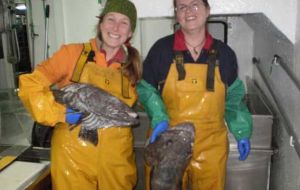MercoPress. South Atlantic News Agency
Falklands' cutting edge research into toothfish resource
 Scientist Judith Brown and Sarah Hearne, Fisheries Observer
Scientist Judith Brown and Sarah Hearne, Fisheries Observer RESEARCH into valuable Falklands resource, Toothfish, is being undertaken by the Falkland Islands Fisheries Department and funded by successful Falklands' fishing company Consolidated Fisheries Limited
With the use of cutting edge technology tagging -age, growth, reproduction and migration routes of toothfish are being investigated. Previous tagging experiments have been carried out around South Georgia, Macquarie and Heard islands using conventional tags which rely on the recapture of the fish. FIG scientists told Mercopress, "As only one longliner operates in Falkland's waters the likelihood of retrieving tagged fish is minimal so we decided to try a different approach. " A company called Wildlife Computers Limited has designed a pop-up tag which stores the data in the tag's memory and attaches into the body of the fish. It records depth, temperature and time. After a preset time (6 months) or if the fish dies or goes below 1800m the tag releases itself from the fish and pops to the surface where it downloads the stored data via a satellite system. It also gives an exact position of where the fish has traveled to. Only large fish over 130cm are tagged, this ensures the fish will be mature (the scientists want to track spawning migrations) and also gives the fish the best chance of survival as the tags are quite large. A spokesperson for the Falkland Islands Fisheries Department Scientists said, "The captain and crew were fantastic helping haul these large fish (over 50kg) onto the deck using a hand net so we could tag and then release them. "So far ten tags have been deployed and two have successfully transmitted their data with the further eight due to pop up in September. Data so far has shown the fish generally moved approximately 50 vertical meters each day". There are also several periods of large daily vertical migrations of the toothfish with it moving up to a maximum of 456m in one day. Between the end of September to mid December the fish were mainly at a depth of 1200m, moving deeper to 1300m in mid December and then to 1550m by the end of December. The tagged toothfish remained in water temperatures ranging from 2.5-3.5°C. Of the two tags returned so far one fish moved over 250km horizontally whereas the other remained close to the tagging position moving only 25km. This exciting new research allows the scientists to determine migration routes of toothfish between spawning and feeding grounds as well as daily and seasonal depth movements of the individual fish. This is an ongoing project with ten more tags just about to be deployed so scientists can also examine any differences between years. Info: Patagonian Toothfish is a large fish which inhabits deep polar waters in the Southern Ocean and can attain 220 cm in length (150kg or 330lb). They generally live north of the Antarctic convergence and are found in the near shelf and slope waters of South America and the sub-Antarctic islands. With their high value flesh they are an important commercial fishery with a set TAC (Total Allowable Catch) being caught annually around the Falkland Islands. Toothfish are a long lived species and have been reported to survive for up to 35 years in the Falkland Islands and up to 53 years at higher latitudes. By Lisa Johnston – SealedPR – Stanley




Top Comments
Disclaimer & comment rulesCommenting for this story is now closed.
If you have a Facebook account, become a fan and comment on our Facebook Page!